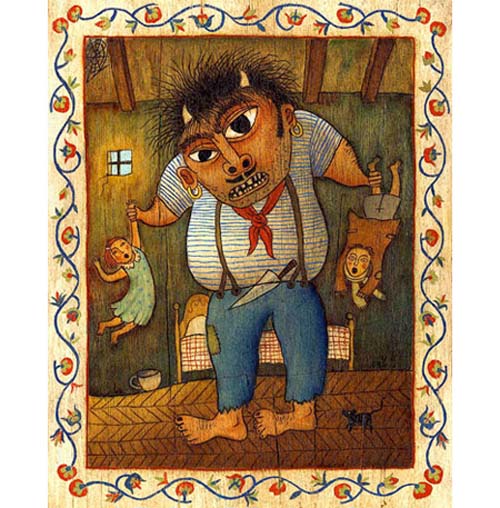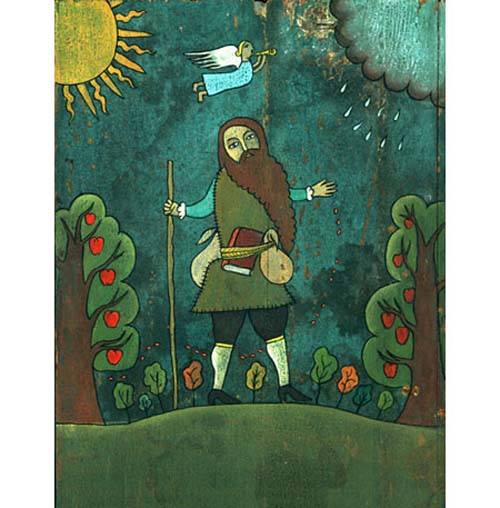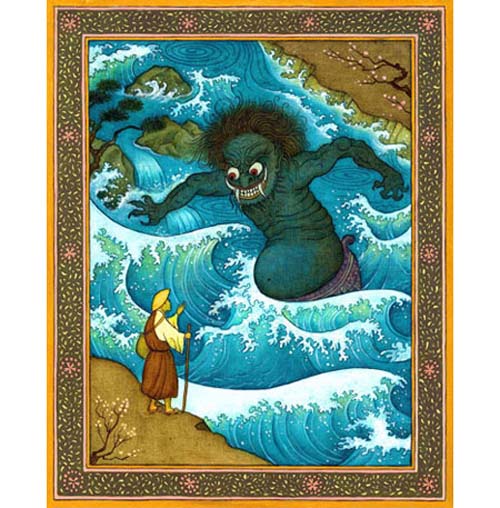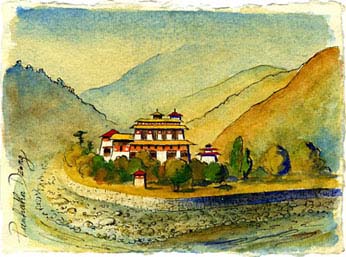Seven Questions Over Breakfast with Stefano Vitale
 March 2nd, 2009 by jules
March 2nd, 2009 by jules
 Here’s one of the best things about blogging: I get to chat with book-creators whose work I have admired for a long time. Illustrator Stefano Vitale is one of those people. His art work is a force of nature, and whenever I see that he’s illustrated a new title, I run to find a copy.
Here’s one of the best things about blogging: I get to chat with book-creators whose work I have admired for a long time. Illustrator Stefano Vitale is one of those people. His art work is a force of nature, and whenever I see that he’s illustrated a new title, I run to find a copy.
Even though I didn’t get to chat with him directly—this was one of those interviews conducted via his publicist (I’m sure he’s a very busy guy, so this is hardly a complaint)—I’m still thrilled that I was two degrees away from someone whose art work has brought me so much joy. Better yet, I get to either share it with fellow fans today OR introduce the uninitiated to his books and show you what his paintbrush can produce. Both things are big kicks, indeed.

Stefano, born in Italy, started out studying Economics and Social Sciences. And, while I have no doubt he excelled at those fields of study, I admit I’m glad he turned to the arts after that. Or we wouldn’t have the dazzling art you see below. While studying at the Art Center College of Design in Pasadena, California, he quickly became known, as his bio states, “for always painting the same thing for every assignment — a madonna with one eye.” While living in California, Stefano traveled extensively throughout Mexico and Central America; the results of these travels can be seen in his vibrant signature folk-art style today. After graduating and looking for work in New York, he ended back up in Italy, and…well, you can read more about that below in his answer to the stompin’-grounds question.
Now, there are the children’s titles he’s illustrated. Does it get any better than this for sheer drama and an illustrator getting right to the very center—and the inherent (and exhilarating) fright—of a piece?

Judy Sierra’s Can You Guess My Name?: Traditional Tales Around the World; Clarion Books; 2002
…But at his site’s bio, he also lists his clients in both the editorial and advertising worlds, as well as the many awards and honors received over the years. (Incidentally, I think Stefano inadvertently skipped the question about his medium-of-choice, but I would venture it can best be summarized as mixed media on board.) Click on those links I just threw in (“editorial” and “advertising”), and you just might be surprised, as I was, that he painted those. (I mean, just when I think I can recognize a piece of work by one of my favorite illustrators, things like that trip me up. In other words, picture me exclaiming, Ohhhhh! I’ve seen those before. That was Stefano Vitale?! Throw in the hand-to-forehead slap, and there you have it.)
 I’ve seen a copy of one of his forthcoming illustrated titles, written by the prolific and talented picture book author/illustrator Teri Sloat, and to be published this July by Henry Holt: There Was an Old Man Who Painted the Sky. This imaginative tale takes the pivotal 1879 discovery of paintings by the young child Maria Marcelino on the ceilings of Altamira Cave in Spain and hangs it on the frame of the classic cumulative children’s song, “There Was an Old Lady Who Swallowed a Fly.” (“There was an old man who painted the sky, But I don’t know how he painted the sky—It’s up so high!”) The book’s larger themes, if you will, address the wonder in considering the creation of our world and the discovery of such awesome beauty in the last place you’d expect it, and if anyone were going to depict such elemental images and be given the challenge of expressing the wonder and beauty and colors and brilliance of this world we live in—and its very creation—I’m glad it was Vitale. I’d go so far as to say he was the perfect choice to illustrate this title.
I’ve seen a copy of one of his forthcoming illustrated titles, written by the prolific and talented picture book author/illustrator Teri Sloat, and to be published this July by Henry Holt: There Was an Old Man Who Painted the Sky. This imaginative tale takes the pivotal 1879 discovery of paintings by the young child Maria Marcelino on the ceilings of Altamira Cave in Spain and hangs it on the frame of the classic cumulative children’s song, “There Was an Old Lady Who Swallowed a Fly.” (“There was an old man who painted the sky, But I don’t know how he painted the sky—It’s up so high!”) The book’s larger themes, if you will, address the wonder in considering the creation of our world and the discovery of such awesome beauty in the last place you’d expect it, and if anyone were going to depict such elemental images and be given the challenge of expressing the wonder and beauty and colors and brilliance of this world we live in—and its very creation—I’m glad it was Vitale. I’d go so far as to say he was the perfect choice to illustrate this title.
Pictured here are also some illustrations from another forthcoming title, which I haven’t yet had the pleasure of seeing but look forward to reading, Betsy Franco’s Pond Circle, to be released this year by Margaret K. McElderry Books:


This morning for our cyber-breakfast chat, Stefano has opted for “yoghurt (real one, not factory-made); bread and home-made jam; big cup of coffee with little cold milk and no sugar. Occasionally, some cereal stolen from my kids.” As our devoted readers know, “a big cup of coffee” is my favorite answer. Let’s get right to it and get the basics from Stefano while we set the table for some confiscated cereal and coffee. I thank him kindly for taking the time to stop by and chat and share his art work.
7-Imp: Are you an illustrator or author/illustrator?
Stefano: Illustrator.

7-Imp: Can you list your books-to-date?
Stefano:
- The Folks in the Valley: A Pennsylvania Dutch ABC by Jim Aylesworth. Harper Collins.
- When the Wind Stops by Charlotte Zolotow. Harper Collins.
- The Story of Easter by Aileen Fisher. Harper Collins.
- The Rose’s Smile: Farizad of the Arabian Nights by David Kheridian. Henry Holt & Co.
- The World in 1492. Henry Holt & Co.
- Nursery Tales Around the World, written by Judy Sierra. Clarion Books.
- Christmas Lullaby by Nancy Jewell. Clarion Books.
- When Stories Fell Like Shooting Stars by Valiska Gregory. Simon & Schuster.
- Too Much Talk by Angela Shelf Medearis. Candlewick Press.
- Magic Words by Edward Field. Harcourt Brace.
- Sailor Song by Nancy Jewell. Clarion Books.
- If You Listen by Charlotte Zolotow. Running Press.
- Sleepy Book by Charlotte Zolotow. Harper Collins.
- Can You Guess My Name? Traditional Tales Around the World, written by Judy Sierra. Clarion Books.
- There is a Flower at the Tip of My Nose Smelling Me by Alice Walker. Harper Collins.
- There Was an Old Man Who Painted the Sky by Teri Sloat. Henry Holt.
- Pond Circle by Betsy Franco. Simon and Schuster.
- Why War is Never a Good Idea by Alice Walker. Harper Collins.
- The Girl Who Helped Thunder and Other Native American Folktales {re-told} by James and Joseph Bruchac. Sterling Press.


7-Imp: If you have illustrated for various age ranges (such as, both picture books and early reader books OR, say, picture books and chapter books), can you briefly discuss the differences, if any, in illustrating for one age group to another?
Stefano: I never think much about who the images are for; that’s the job of the marketing people. I paint for myself, mostly; of course, the text already forces you to create images that appeal to different age groups, but I don’t consciously distinguish a child from an adult.
 7-Imp: Where are your stompin’ grounds?
7-Imp: Where are your stompin’ grounds?
Stefano (pictured here on one of his travelling adventures): My stomping grounds have been California, New Mexico, New York, {and} Long Island, but at the moment I am living in Venice, Italy, where there is little ground to stomp. As I write, the water level is reaching the ground floor; I hope we won’t get flooded again.
7-Imp: Can you briefly tell us about your road to publication?
Stefano: Chance, as usual. My first book, The Folks in the Valley, was a result of an editor at Harper Collins interested in my illustrations and my interest in the lifestyle of the Amish people.
7-Imp: Can you please point us to your web site and/or blog?
Stefano: www.stefanovitale.com.

7-Imp: If you do school visits, tell us what they’re like.
Stefano: Lots of fun. At first, I am very shy, but at the end they have to kick me away, because I don’t want to leave my new friends.

A Novel of Johnny Appleseed’s Life; Clarion Books; 2003.
7-Imp: If you teach illustration, by chance, tell us how that influences your work as an illustrator.
Stefano: Can illustration be taught? I doubt it.


7-Imp: Any new titles/projects you might be working on now that you can tell us about?
Stefano: Sorry. It’s top-secret.
(HarperCollins; 2007):
“Though War speaks / Every language / It never knows /
What to say / To frogs.”
 Okay, the table’s set for our seven questions over breakfast, and now we’re ready to talk more specifics. Once again, I thank Stefano for cyber-stopping by.
Okay, the table’s set for our seven questions over breakfast, and now we’re ready to talk more specifics. Once again, I thank Stefano for cyber-stopping by.
1. 7-Imp: What exactly is your process when you are illustrating a book? You can start wherever you’d like when answering: getting initial ideas, starting to illustrate, or even what it’s like under deadline, etc. Do you outline a great deal of the book before you illustrate or just let your muse lead you on and see where you end up?
Stefano: Step one: read the text carefully. Step two: re-read the text over and over until an image pops up in the mind. At that point, find somewhere in the text some other images that relate to the first; then a third one; and so on. Step three: Find a common-denominator idea parallel to the text. Step four: Find images for the text that didn’t convey images right away to support and enhance the images that popped up first. Step five: Match form with content, find a rhythm (very important), alternating pauses and movement in the composition, bright or somber, cool or warm colors, etc.
 Last step: Can I read the story without knowing how to read? If not, back to the drawing board.
Last step: Can I read the story without knowing how to read? If not, back to the drawing board.
When you are ready to go to final paintings, prepare all the boards first and paint at the same time — all of them like it were only one piece.
{Ed. Note: Pictured here is a spread from Alice Walker’s There is a Flower at the Tip of My Nose Smelling Me; HarperCollins; 2006}
 2. 7-Imp: Describe your studio or usual work space for us.
2. 7-Imp: Describe your studio or usual work space for us.
Stefano: Very clean and organized at the beginning of a project and {a} total mess at the end.
{Ed. Note: More images from Stefano’s studio can be seen at this page of his site.}
3. 7-Imp: As book lovers, it interests us: What books or authors and/or illustrators influenced you as an early reader?
Stefano: Honestly, I don’t know. As a teenager, I loved Dino Buzzati, my cousin’s relative, but everything I read or watched influenced me. Sometimes I can tell where some ideas came from, but my real muse is plain hard work.
4. 7-Imp: If you could have three (living) illustrators—whom you have not yet met—over for coffee or a glass of rich, red wine, whom would you choose?
Stefano: I met many important illustrators in my career, and some are dear friends, but the truth is that I am not very interested in who’s who and who does what. I would choose anyone who doesn’t talk only about illustration.
Why War Is Never a Good Idea; HarperCollins; 2007:
“Now, suppose You / Become War / It happens / To some of / The nicest / People / On earth: / & one day / You have / To drink / The / Water / In this place.”
 {Ed. Note: Pictured here is one of Stefano’s personal sketches from a “trekking trip” through Bhutan. “Along the way, he stopped to sketch and compare drawings with the monks,” his site states. For more of these sketches, visit this page of his site.}
{Ed. Note: Pictured here is one of Stefano’s personal sketches from a “trekking trip” through Bhutan. “Along the way, he stopped to sketch and compare drawings with the monks,” his site states. For more of these sketches, visit this page of his site.}
5. 7-Imp: What is currently in rotation on your iPod or loaded in your CD player? Do you listen to music while you create books?
Stefano: Music is my daily bread. I go through periods. At the moment, I am hooked to Turkish traditional music, but Brian Eno has always been my favorite. Classical music is my faithful friend, since I was a teenager; right now I am listening to Shostakovich, another idol of mine, together with Chopin.

6. 7-Imp: What’s one thing that most people don’t know about you?
Stefano: What I hide from them.
{Ed. Note: Pictured here is an illustration from Charlotte Zolotow’s When the Wind Stops, one of My Favorite Picture Books of All Time, originally illustrated by Howard Knotts in 1975, but re-illustrated by Vitale in 1995 (HarperCollins).}
7. 7-Imp: Is there something you wish interviewers would ask you — but never do? Feel free to ask and respond here.
Stefano: What’s your favorite saying?
To live and let live.

(which has since ceased publication)
 Belly Pooch, created for Parenting Magazine
Belly Pooch, created for Parenting Magazine
Neither Stefano nor his agent nor his publicist asked me to say this, but if you’re a fellow-geeky fan of his work and like what you see and want prints, the company which represents him—Lindgren & Smith (in NYC)—offers commisioned work, stock images, and limited edition prints of some of his images, using archival inks and papers. The link is here. (Map-lovers won’t want to miss the Stefano maps at the Lindgren & Smith site.)
7-Imp: What is your favorite word?
Stefano: “Love.”
7-Imp: What is your least favorite word?
Stefano: “Juxtaposition.”
7-Imp: What turns you on creatively, spiritually or emotionally?
Stefano: Silence.
7-Imp: What turns you off?
Stefano: Hypocrisy.
7-Imp: What is your favorite curse word? (optional)
Stefano: “Fuck.”
7-Imp: What sound or noise do you love?
Stefano: Nightingales, ocean waves.
7-Imp: What sound or noise do you hate?
Stefano: People screaming.
7-Imp: What profession other than your own would you like to attempt?
Stefano: Writer.
7-Imp: What profession would you not like to do?
Stefano: Judge.
7-Imp: If Heaven exists, what would you like to hear God say when you arrive at the Pearly Gates?
Stefano: “You are late.”

Spreads from WHY WAR IS NEVER A GOOD IDEA: © 2007 by Alice Walker. Illustration © 2007 Stefano Vitale. Published by HarperCollins Books. New York, NY. All rights reserved.
Spreads from THE GIRL WHO HELPED THUNDER: Reprinted with permission of Sterling Publishing Co., Inc., from The Girl Who Helped Thunder and Other Native American Folktales, retold by James Bruchac and Joseph Bruchac, Ph.D., illustrated by Stefano Vitale. Copyright © 2008 by Stefano Vitale.
Spreads from POND CIRCLE: © 2009 by Betsy Franco. Illustration © 2009 Stefano Vitale. Published by Margaret K. McElderry, an imprint of Simon & Schuster. New York, NY. All rights reserved.
All other illustrations and photos courtesy of Stefano Vitale, either sent to me or taken from his site with his permission. All rights reserved and all that good stuff. Be cool; don’t take these images for yourself without permission. Thank you.

Wow, what a hoot to find out the name of a guy who’s work I’ve seen and liked in various magazines for ages. Wow. I love the style, I love the folksy sort of flat-perspective thing that painting on a board gives. I love the colors. Wow. Just… wow.
I’m in love with Stefano’s work! I love that old world/folk art feel. Such rich, deep colors. To live and work in Venice — wow. It’s THE most romantic city I’ve ever visited in my life. “California Cuisine” makes me really happy :). Thank you.
Jama, I totally thought of you when I saw California Cuisine.
I agree with Jama — “old world/folk art feel” is right. From the first couple images, I thought of Russian icons with (especially the second one) a heavy dose of whichever Breughel it was who did all the hellish-grotesquerie stuff. (I see what Stefano means when he says he doesn’t distinguish between “art for children” and “art for adults.” :))
Cool stuff as always to be found here, Jules. Thanks! (And thanks to Stefano Vitale, too — I *LOVE* the maps!)
Thanks for another light-filled and inspiring feature. S.V’s work makes my spirit sing!
Good morning, Stefano!
Ladies: Saw this making-the-record video with Neko Case and thought of you: Borders Media: Neko Case: Middle Cyclone
Such awesome work! Every time I read this blog I have a new list of books to check out from the library, I think they are getting sick of me!
Thanks for turning us on to Stefano’s work.
I’ve not had the privilege of coming across Stefano’s work in the past but I am definitely a fan now and will seek out more of it.
Thanks!
!!!!?=)(/&/(HE?S??!!!.
Stefano’s image “Lightning Out of Heaven” meant so much to me that I tracked him down. I contacted him through a gallery in NYC to see if I could purchase a print. When they contacted him, he said, “I still have it, and I like it.” He offered it to me at a very reasonable price. It is a treasure. Thank you, Stefano.
Vizuka, that is a great story. Thanks for sharing.
oh, thank you for this wonderful interview. I am mesmerized by Stefano’s images, and I enjoyed getting to know him a bit more. I would love to know more about his interpretation of the lovely way women and children are portrayed in his work. He seems to have a reverence for them (us:) Thank you again!
I have loved Stefano’s work for years and much to my suprise (from this fantastic interview! ) i learned that we have some things in common – eno and one eyed madonnas! I too love his portrayal of women , esp the mother, and have found so much comfort in these images as i grieve the loss of a baby. Thank you so much for this interview and this site! It is inspiring for this isolated illustrator! I’ll be linking this blog to my favorites.
Thanks, Stephanie. I’m glad the images are helpful. So glad. Yes, his work is beautiful. So glad he visited 7-Imp.
Thanks to you, too, Holly. Yes, it seems to be true, doesn’t it?
Really enjoy Creation rabbit ear film!
I love the art work!